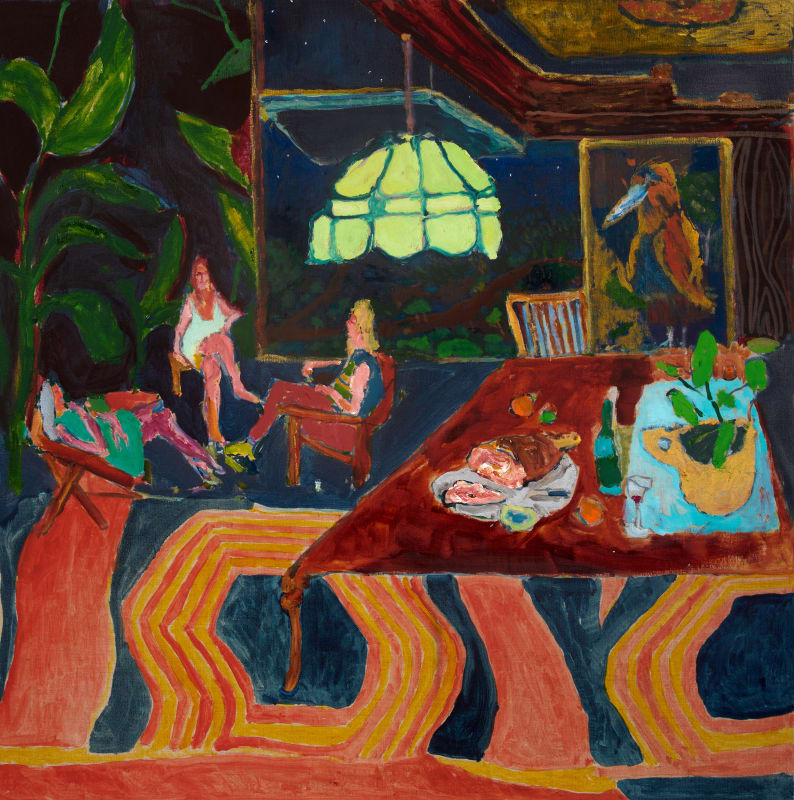Bradley Wood: Notes From a Lucid Dream
“Fantastic as it may sound, I was in full possession of my waking faculties while dreaming and soundly asleep: I could think as clearly as ever, freely remember details of my waking life, and act deliberately upon conscious reflection. Yet none of this diminished the vividness of my dream. Paradox or no, I was awake in my dream!”
-Stephen LaBerge, Lucid Dreaming (1986)
Jane Lombard Gallery is pleased to present Notes from a Lucid Dream, a solo exhibition of new paintings by Canadian artist Bradley Wood. The featured works transport viewers into the lavish domestic environment of Wood’s envisioned dreamscape, where conspicuous consumption is limited by imagination alone. The exhibition will be on view from October 27 - December 16, with an opening reception on Friday, October 27 from 6 - 8 PM.
Notes from a Lucid Dream displays an illusive vision of luxury that straddles desire, material wealth, and ennui. Wood affords the voyeuristic viewer a forbidden glimpse of what he envisions to be unfolding within the walls of society’s most palatial mansions, implying a sense of longing curiosity on behalf of artist and audience alike. Drawing from his own dreamlike states, Wood frequently renders the human body as composite, destabilizing distinctions between inside and outside, figure and ground, reality and fiction; eccentric characters materialize from the drapes, march out of the walls, or else evanesce into amorphous entities of color and fabric. In Lounging with Gloria enigmatic figures are delineated by sensual tones and swaths of thick oil paint as they lounge languidly about their extravagant surroundings. Engaged in the pursuit of recreational pleasure, the depicted figures seduce viewers with their unobtainable lifestyles and apparent ease of living. Elsewhere, such as in Squeak, furniture and fixtures blend together in a swirl of generative delirium as surreal figures are actively spawned from the garish confusion, merging bodies with their encompassing possessions.
Referring to his paintings as “domestic fictions,” Wood enlists the depicted figures as actors to communicate the seductive nature of wealth and the widespread desire to inhabit such spaces of luxury. Much like characters in a play, the actors are tasked with generating an atmosphere of reality that captures a fascination with wealth and excess but also an inexplicable associated anxiety. Indeed, Wood’s figures are underscored by an unsettling sense of unease reminiscent of Surrealism and late nineteenth-century Decadence, providing a visual exploration of the mind’s vulnerability to its milieu; how do lifestyles of unconstrained material wealth signify for the denizens of such luxurious domains? In a similar manner, Wood’s unrestrained application of oil paint, itself luscious and rich, maintains a dialogue between formal technique and content. The pleasurable experience of applying luscious oils to canvas is at once sensual and abject, treading a fine line between buttery seduction and muddy chaos.
Wood’s canvases are ultimately an amalgamation of fragments of memories, dreams, and encounters that are recombined and translated through his distinctive vision and technical skill. The paintings sustain a tension between the post-Modern and the opulence and paint application of 17th Century still-life paintings, late-18th Century Rococo artists, French Baroque and early Modernist German Expressionists. Wood cites the technical handling of French painter ChaÏm Soutine as the inspiration behind his interest in exploring the transformative properties of oil paint and its capacity to stimulate a visceral response. His resulting dreamscapes occupy the delicate space between quiet luxury and aspirational excess, providing an exploratory inquiry into humanity’s complex and conflicting relationship with material wealth.






